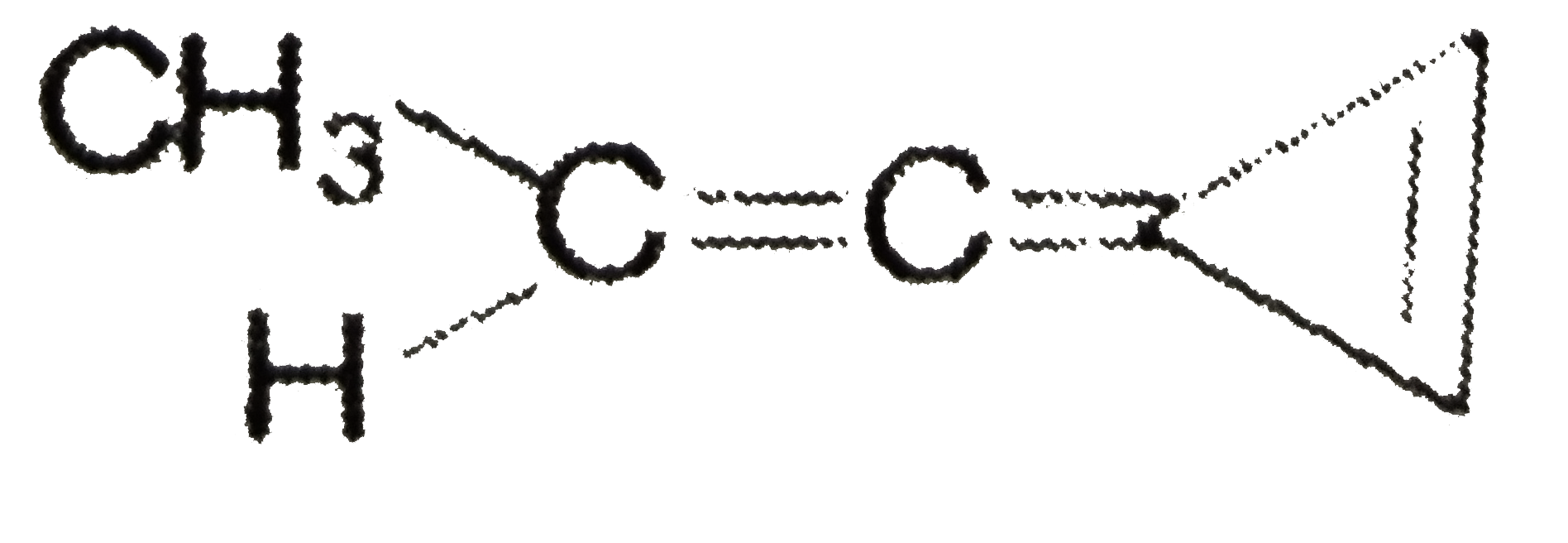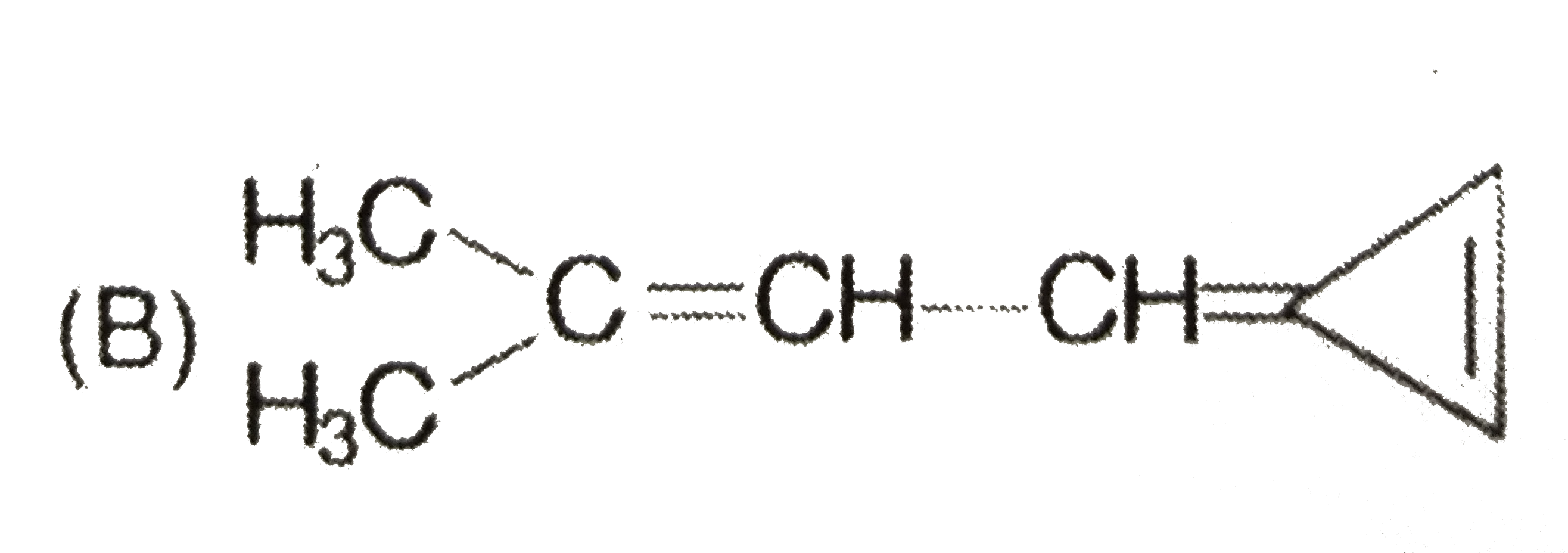Alkene ΛO/H2O−−−−→CH3O∣∣CCH3+CHCHO+CH3−C∣∣O−C∣∣O−CHO A can be :

C(CH3)2 ||CH3CCH=CHCH3
Both are correct
None is correct
The correct Answer is:C
To determine the alkene A that undergoes ozonolysis to yield the given products, we can follow these steps:
Step 1: Understand the Ozonolysis Reaction
Ozonolysis is a reaction where an alkene reacts with ozone (O₃) to form ozonides, which can subsequently decompose to yield carbonyl compounds (aldehydes or ketones). The general idea is that the double bond in the alkene is cleaved, and oxygen is added to form carbonyl groups.
Step 2: Analyze the Products
The products given are:
1. CH₃CHO (acetaldehyde)
2. CH₃C(=O)C(=O)CHO (which is essentially two carbonyl groups, indicating a compound with two aldehyde functionalities)
Step 3: Identify the Structure of Alkene A
To find the alkene A that would yield these products upon ozonolysis, we can reverse the ozonolysis reaction:
- The presence of CH₃CHO suggests that one of the fragments must be an aldehyde with a methyl group.
- The other fragment must also contain a carbonyl group.
Step 4: Construct the Alkene
To produce both CH₃CHO and CH₃C(=O)C(=O)CHO, we can consider the following:
- The alkene must have a structure that, when cleaved, results in these two products.
- A plausible alkene structure is 2-butene (CH₃-CH=CH-CH₃), which upon ozonolysis would yield:
- CH₃CHO from one end of the double bond.
- CH₃C(=O)CHO from the other end.
Step 5: Confirm the Reaction
When 2-butene undergoes ozonolysis, it would yield:
- From one side: CH₃CHO (acetaldehyde)
- From the other side: CH₃C(=O)CHO (which can be represented as CH₃C(=O)C(=O)CHO)
Thus, the alkene A that would yield the products specified in the question is 2-butene.
Final Answer
Alkene A is 2-butene.
---
Ozonolysis is a reaction where an alkene reacts with ozone (O₃) to form ozonides, which can subsequently decompose to yield carbonyl compounds (aldehydes or ketones). The general idea is that the double bond in the alkene is cleaved, and oxygen is added to form carbonyl groups.
The products given are:
1. CH₃CHO (acetaldehyde)
2. CH₃C(=O)C(=O)CHO (which is essentially two carbonyl groups, indicating a compound with two aldehyde functionalities)
To find the alkene A that would yield these products upon ozonolysis, we can reverse the ozonolysis reaction:
- The presence of CH₃CHO suggests that one of the fragments must be an aldehyde with a methyl group.
- The other fragment must also contain a carbonyl group.
To produce both CH₃CHO and CH₃C(=O)C(=O)CHO, we can consider the following:
- The alkene must have a structure that, when cleaved, results in these two products.
- A plausible alkene structure is 2-butene (CH₃-CH=CH-CH₃), which upon ozonolysis would yield:
- CH₃CHO from one end of the double bond.
- CH₃C(=O)CHO from the other end.
When 2-butene undergoes ozonolysis, it would yield:
- From one side: CH₃CHO (acetaldehyde)
- From the other side: CH₃C(=O)CHO (which can be represented as CH₃C(=O)C(=O)CHO)
Alkene A is 2-butene.
Topper's Solved these Questions
- BOOK - NARAYNACHAPTER - HYDROCARBONS EXERCISE - CHECK YOUR GRASP8videos
HYDROCARBONS
- BOOK - NARAYNACHAPTER - HYDROCARBONS EXERCISE - C.U.Q (NOMENCLATURE, ISOMERISM)6videos
HYDROCARBONS
- BOOK - NARAYNACHAPTER - HYDROCARBONS EXERCISE - EVALUATE YOURSELF - 44videos
HYDROCARBONS
- BOOK - NARAYNACHAPTER - GENERAL ORGANIC CHEMISTRYEXERCISE - Matrix-Match type questions7videos
GENERAL ORGANIC CHEMISTRY
- BOOK - NARAYNACHAPTER - HYDROGEN & ITS COMPOUCDSEXERCISE - Interger type questions10videos
HYDROGEN & ITS COMPOUCDS
Similar Questions
Knowledge Check
- Question 1 - Select One
(X)O3/Zn−−−→H2OCO2+CH3−C∣∣O−H+OHC−C∣∣O−CHO
X isA B
B C
C D
D
- Question 2 - Select One
Alkene (z)O3−−−−→Zn,H2OCH3−C∣∣O−Ph+CH3−C∣∣O=CH=O+CH3−CH=O
Alkene (Z) can beACH3−C−CH∣∣CH3−C−CH3=CH−PhBCH3−C−Ph∣∣CH3−C−CH=CH−CH3CCH3−C=CH−Ph∣CH3−C=CH−CH3DPh−C−CH∣∣CH3−C−CH3=CH−CH3 - Question 3 - Select One
:−CH2−C∣∣:O:−CH3andCH2=C∣(.−:O:)−CH3
Aresonance structureBtautomersCgeometrical isomersDoptical isomers
CH3−CH3∣C∣CH3−CH2−C∣∣O−NHCH3
View SolutionIn the reaction
CH3−C≡C−CH3(i)X−−−−−−−−→(ii)H2/ZnCH3−C∣∣O−C∣∣O−CH3 X is:View SolutionThe IUPAC name of compound
CH3−O∣∣C−C∣CH3H−C∣CHOH−C∣CH3H−CH3 is :View SolutionThe IUPAC name of CH3−O∣∣C−CH∣ C2H3−CH∣CH3−CH3 is:
View SolutionThe order of stability of the following tautomeric compounds is
(i). CH2=OH∣CH−CH2−O∣∣C−CH3⇔
(ii). CH3−O∣∣C−CH2−O∣∣C−CH3⇔
(iii). CH3−OH∣C=CH−O∣∣C−CH3View Solution

